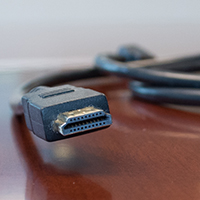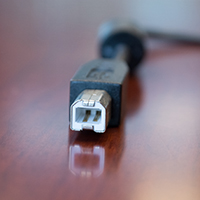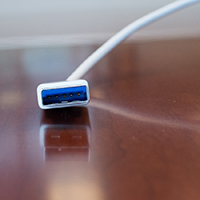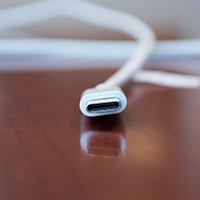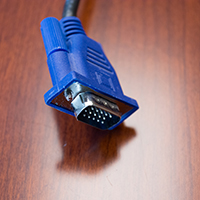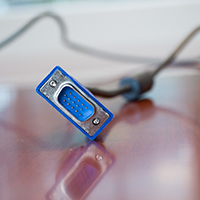Your Definitive Guide to Computer Cable Types

At first glance, most computer cables look pretty similar. When you’re not familiar with each cord, it can be easy to mix them up. So we’ve compiled a guide to common cables you should know along with their differences and their uses, all in one place!
HDMI – High-Definition Multimedia Interface
Your HDMI (high-definition multimedia interface) cord is pretty standard. Unfortunately, it can be easily mixed up with a display port cable. You can tell the difference by looking at the corners. An HDMI cable has two full corners and two inverted ones.
HDMI cables are used to connect digital audio/video devices, i.e. your laptop to your monitors, your game console to your TV, and more. This cord is the most common connector for most televisions, but your resolution via HDMI can be limited depending on the device.
Display Port
Display port cables are primarily used to connect computers to monitors. Unlike with HDMI cords, most televisions do not come with a display port.
You can easily tell the display port apart from the HDMI cable once you know what you’re looking for. As you can see here, a display port cable has three full corners, whereas the HDMI only has two.
USB
Hold onto your hats, folks, because we’re about to go on a wild tour of USB (universal serial bus) cables.
USB Type-A or 2.0
The USB cord is probably the most universally used and recognized, but it actually comes in multiple shapes, sizes, and colors. This USB, the standard USB cable, is called USB Type A. USBs are typically used to charge low-powered electronics like your phone or tablet.
USB Type B
Yes, this little guy is also a USB cable. USB Type B is typically used to plug into peripherals (printers, copiers, etc.).
USB Type C or 3.0
This USB cable looks a lot like the ones we usually see. Its main defining characteristic is the little blue bar (as opposed to the typical white bar).
Whether you’ve got a USB 3.0 or the standard USB 2.0 doesn’t really matter much to the typical user in that they use the same ports and have equal compatibility to most devices. The USB 3.0, however, is approximately ten times faster than the USB 2.0.
USB 3.1
This is the latest and greatest iteration of the USB cable series. One of our engineers predicts the USB 3.1 format will become the new standard within the next three years.
What’s so great about this one? It fits into your smaller devices like your phone, tablet, and more, but it’s just as capable as the larger USBs. You typically see a USB 3.1 paired with a USB 3.0 on the other end.
VGA
VGA (video graphics array) cables are pretty old-school. These cables use an analog signal, so the pictures aren’t as sharp when you connect your television to your devices.
Most monitors come with a VGA cable because it was the most common cable on a global scale for quite some time. And these cords are pretty cheap to buy (we have too many of these cables floating around in our equipment room right now).
If you’re using LCD monitors, you don’t want to go with a VGA connection. It just won’t display as well as other options because it’s an analog signal, despite its capability for relatively high resolutions and frame rates.

DVI
There are two different types of DVI (digital visual interface) cables. DVI-D and DVI-I. The one pictured here is a DVI-D. With a DVI-D, you have that horizontal line next to the series of dots. In DVI-I cables, the horizontal line has two dots above the line and two dots below it. This cable has several other iterations, but these two are the ones you’re most likely to encounter.
A DVI cable is primarily used to carry video signals. Not all DVI cables do audio, so if you’re looking to hook something up to your television, you should go with a different option like HDMI. If you want to connect monitors to your computer, DVI cables should work just fine.
We’ve found, however, that these display drivers can use up a lot of your computers’ processing power, especially when paired with an adapter to dock it with newer computers.
Ethernet
An Ethernet cable connects two wired network devices. I have one currently connecting my desk phone to my laptop’s dock, allowing my phone to access my computer (gotta love those softphones) and my computer to access the internet through my phone, so I only have to use the wireless as a backup. Another connects my phone to our network. Chances are high that you have more than one at your desk too.
Ethernet cables are arguably the most popular type of networking cables, and they’re pretty easily identifiable. For those of you who still remember landlines, an Ethernet cord looks very similar to your old telephone cords. Ethernet cables, however, have a wider plug.


Related Posts
Subscribe to Rocket IT's Newsletter
Stay up to date on trending technology news and important updates.

Find out if Rocket IT is the right partner for your team
Claim a free consultation with a technology expert.


